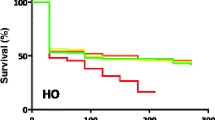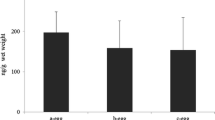Abstract
Polycyclic aromatic hydrocarbons (PAHs) are widespread fused-ring contaminants formed during incomplete combustion of almost all kind of organic materials from both natural and anthropogenic sources. Some PAHs have been shown to be carcinogenic to humans, and a wide range of PAHs are found in wildlife all around the globe including avian species. The purpose of this project was to assess the effects of a standard mixture of 16 PAHs (United States Environmental Protection Agency) on the hepatic fatty acid β-oxidation in chicken embryos (Gallus gallus domesticus) exposed in ovo. The hepatic β-oxidation was measured using a tritium release assay with [9,10-3H]-palmitic acid (16:0) as substrate. Treated groups were divided into groups of 0.05, 0.1, 0.3, 0.5, and 0.8 mg PAHs/kg egg weight. The hepatic β-oxidation was reduced after exposure in ovo to the 16 PAHs mixture compared to control. The mechanisms causing reduced fatty acid oxidation in the present study are unclear, however may be due to deficient membrane structure, the functionality of enzymes controlling the rate of fatty acid entering into the mitochondria, or complex pathways connected to endocrine disruption. To the best of our knowledge, this is the first time a PAH-caused reduction of hepatic β-oxidation of fatty acids in avian embryos has been observed. The implication of this finding on risk assessment of PAH exposure in avian wildlife remains to be determined.





Similar content being viewed by others
References
Albers PH (2006) Birds and polycyclic aromatic hydrocarbons. Avian Poult Biol Rev 17:125–140
Andersson E, Rotander A, von Kronhelm T, Berggren A, Ivarsson P, Hollert H, Engwall M (2009) AhR agonist and genotoxicant bioavailability in a PAH-contaminated soil undergoing biological treatment. Environ Sci Pollut Res 16:521–530
Ashwell CM, Czerwinski SM, Brocht DM, McMurtry JP (1999) Hormonal regulation of leptin expression in broiler chickens. Am J Physiol Regul Integr Comp Physiol 276:R226–R232
Bonnet JL, Guiraud P, Dusser M, Kadri M, Laffosse J, Steiman R, Bohatier J (2005) Assessment of anthracene toxicity toward environmental eukaryotic microorganisms: Tetrahymena pyriformis and selected micromycetes. Ecotoxicol Environ Saf 60:87–100
Brausch JM, Blackwell BR, Beall BN, Caudillo C, Kolli V, Godard-Codding C, Cox SB, Cobb G, Smith PN (2010) Effects of polycyclic aromatic hydrocarbons in Northern bobwhite quail (Colinus virginianus). J Toxicol Environ Health A 73:540–551
Brunström B (1991) Toxicity and erod-inducing potency of polychlorinated biphenyls (PCBs) and polycyclic aromatic hydrocarbons (PAHs) in avian embryos. Comp Biochem Physiol C: Comp Pharmacol 100:241–243
Brunström B, Broman D, Näf C (1990) Embryotoxicity of polycyclic aromatic hydrocarbons (PAHs) in three domestic avian species, and of PAHs and coplanar polychlorinated biphenyls (PCBs) in the common eider. Environ Pollut 67:133–143
Brunström B, Broman D, Näf C (1991) Toxicity and EROD-inducing potency of 24 polycyclic aromatic hydrocarbons (PAHs) in chick embryos. Arch Toxicol 65:485–489
Chen C-W, Chen C-F (2011) Distribution, origin, and potential toxicological significance of polycyclic aromatic hydrocarbons (PAHs) in sediments of Kaohsiung Harbor, Taiwan. Mar Pollut Bull 63:417–423
Dridi S, Buyse J, Decuypere E, Taouis M (2005) Potential role of leptin in increase of fatty acid synthase gene expression in chicken liver. Domest Anim Endocrinol 29:646–660
Finch BE, Wooten KJ, Smith PN (2011) Embryotoxicity of weathered crude oil from the Gulf of Mexico in mallard ducks (Anas platyrhynchos). Environ Toxicol Chem 30:1885–1891
Gentes M-L, McNabb A, Waldner C, Smits JEG (2007) Increased thyroid hormone levels in tree swallows (Tachycineta bicolor) on reclaimed wetlands of the Athabasca oil sands. Arch Environ Contam Toxicol 53:287–292
Granberg L, Brunström B, Brandt I (2003) Formation of benzo[a]pyrene and 7,12-dimethylbenz[a]anthracene adducts in vascular endothelia of cytochrome P4501A–induced chicken embryos. Environ Toxicol Chem 22:2393–2399
Harvey S, Klandorf H, Phillips JG (1981) Reproductive performance and endocrine responses to ingested petroleum in domestic ducks (Anas platyrhynchos). Gen Comp Endocrinol 45:372–380
Hebert CE, Weseloh DVC, MacMillan S, Campbell D, Nordstrom W (2011) Metals and polycyclic aromatic hydrocarbons in colonial waterbird eggs from Lake Athabasca and the Peace-Athabasca Delta, Canada. Environ Toxicol Chem 30:1178–1183
Herwig A, Ross AW, Nilaweera KN, Morgan PJ, Barrett P (2008) Hypothalamic thyroid hormone in energy balance regulation. Obes Facts 1:71–79
IARC (1987): Overall evaluation of carcinogenicity: an updating of IARC Monographs Volumes 1–42, IARC Monographs on the Evaluation of Carcinogenic Risk of Chemicals to Humans
Irigaray P, Ogier V, Jacquenet S, Notet V, Sibille P, Méjean L, Bihain BE, Yen FT (2006) Benzo[a]pyrene impairs β-adrenergic stimulation of adipose tissue lipolysis and causes weight gain in mice. FEBS J 273:1362–1372
Jenssen BM, Ekker M, Zahlsen K (1990) Effects of ingested crude oil on thyroid hormones and on the mixed function oxidase system in ducks. Comp Biochem Physiol C 95:213–216
Kammann U (2007) PAH metabolites in bile fluids of dab (Limanda limanda) and flounder (Platichthys flesus): spatial distribution and seasonal changes (7 pp). Environ Sci Pollut Res 14:102–108
Kannan K, Perrotta E (2008) Polycyclic aromatic hydrocarbons (PAHs) in livers of California sea otters. Chemosphere 71:649–655
Kerner J, Hoppel C (2000) Fatty acid import into mitochondria. Biochim Biophys Acta Mol Cell Biol Lipids 1486:1–17
Kompare M, Rizzo WB (2008) Mitochondrial fatty-acid oxidation disorders. Semin Pediatr Neurol 15:140–149
Lehr RE, Jerina DM (1977) Metabolic activations of polycyclic hydrocarbons. Arch Toxicol 39:1–6
Lombardi A, de Lange P, Silvestri E, Busiello RA, Lanni A, Goglia F, Moreno M (2009) 3,5-Diiodo-L-thyronine rapidly enhances mitochondrial fatty acid oxidation rate and thermogenesis in rat skeletal muscle: AMP-activated protein kinase involvement. Am J Physiol Endocrinol Metab 296:E497–502
Lopez M et al (2010) Hypothalamic AMPK and fatty acid metabolism mediate thyroid regulation of energy balance. Nat Med 16:1001–1008
Miles KA, Flint PL, Trust KA, Ricca MA, Spring SE, Arrieta DE, Hollmen T, Wilson BW (2007) Polycyclic aromatic hydrocarbon exposure in Steller's eiders (Polysticta stelleri) and Harlequin ducks (Histronicus histronicus) in the eastern Aleutian Islands, Alaska, USA. Environ Toxicol Chem 26:2694–2703
Minnich A, Tian N, Byan L, Bilder G (2001) A potent PPARα agonist stimulates mitochondrial fatty acid β-oxidation in liver and skeletal muscle. Am J Physiol Endocrinol Metab 280:E270–E279
Minokoshi Y, Kim Y-B, Peroni OD, Fryer LGD, Muller C, Carling D, Kahn BB (2002) Leptin stimulates fatty-acid oxidation by activating AMP-activated protein kinase. Nature 415:339–343
Moldoveanu SC (2010) Chapter 23 toxicological and environmental aspects of polycyclic aromatic hydrocarbons (PAHs) and related compounds. In: Serban CM (ed) Techniques and instrumentation in analytical chemistry. Elsevier, Amsterdam, pp 693–699
Näf C, Broman D, Brunström B (1992) Distribution and metabolism of polycyclic aromatic hydrocarbons (PAHs) injected into eggs of chicken (Gallus domesticus) and common eider duck (Somateria mollissima). Environ Toxicol Chem 11:1653–1660
Nordén M, Westman O, Venizelos N, Engwall M (2012) Perfluorooctane sulfonate increases β-oxidation of palmitic acid in chicken liver. Environ Sci Pollut Res 19:1859–1863
Ohkubo T, Tanaka M, Nakashima K (2000) Structure and tissue distribution of chicken leptin receptor (cOb-R) mRNA. Biochim Biophys Acta (BBA) Gene Struct Expr 1491:303–308
Ohura T, Amagai T, Fusaya M, Matsushita H (2003) Polycyclic aromatic hydrocarbons in indoor and outdoor environments and factors affecting their concentrations. Environ Sci Technol 38:77–83
Peakall DB, Tremblay J, Kinter WB, Miller DS (1981) Endocrine dysfunction in seabirds caused by ingested oil. Environ Res 24:6–14
Pereira MG, Walker LA, Wright J, Best J, Shore RF (2009) Concentrations of polycyclic aromatic hydrocarbons (PAHs) in the eggs of predatory birds in Britain. Environ Sci Technol 43:9010–9015
Perera FP, Edwards SC (2011) Prenatal exposure to polycyclic aromatic hydrocarbons (PAHs). In: Jerome ON (ed) Encyclopedia of environmental health. Elsevier, Burlington, pp 659–668
Perez C, Lores M, Velando A (2010) Oli pollution increases plasma antioxidants but reduces coloration in a seabird. Oecologia 163:875–884
Perugini M, Visciano P, Giammarino A, Manera M, Di Nardo W, Amorena M (2007) Polycyclic aromatic hydrocarbons in marine organisms from the Adriatic Sea, Italy. Chemosphere 66:1904–1910
Rawlings JS, Rosler KM, Harrison DA (2004) The JAK/STAT signaling pathway. J Cell Sci 117:1281–1283
Saggerson D (2008) Malonyl-CoA, a key signaling molecule in mammalian cells. Annu Rev Nutr 28:253–272
Schirmer K, Dixon DG, Greenberg BM, Bolts NC (1998) Ability of 16 priority PAHs to be directly cytotoxic to a cell line from the rainbow trout gill. Toxicology 127:129–141
Schwenk RW, Holloway GP, Luiken JJFP, Bonen A, Glatz JFC (2010) Fatty acid transport across the cell membrane: regulation by fatty acid transporters. Prostaglandins Leukot Essent Fatty Acids 82:149–154
Shen H, Tao S, Wang R, Wang B, Shen G, Li W, Su S, Huang Y, Wang X, Liu W, Li B, Sun K (2011) Global time trends in PAH emissions from motor vehicles. Atmos Environ 45:2067–2073
Shore RF, Wright J, Horne JA, Sparks TH (1999) Polycyclic aromatic hydrocarbon (PAH) residues in the eggs of coastal-nesting birds from Britain. Mar Pollut Bull 38:509–513
Silva JE (1995) Thyroid hormone control of thermogenesis and energy balance. Thyroid 5:481–492
Sinha R, Peters U, Cross AJ, Kulldorff M, Weissfeld JL, Pinsky PF, Rothman N, Hayes RB, Prostate L, Colorectal TOCP (2005) Meat, meat cooking methods and preservation, and risk for colorectal adenoma. Cancer Res 65:8034–8041
Skarphedinsdottir H, Hallgrimsson GT, Hansson T, Hägerroth P-Å, Liewenborg B, Tjärnlund U, Åkerman G, Baršienė J, Balk L (2010) Genotoxicity in herring gulls (Larus argentatus) in Sweden and Iceland. Mutat Res/Genet Toxicol Environ Mutagen 702:24–31
Stronkhorst J, Ysebaert TJ, Smedes F, Meininger PL, Dirksen S, Boudewijn TJ (1993) Contaminants in eggs of some waterbird species from the Scheldt estuary, SW Netherlands. Mar Pollut Bull 26:572–578
Troisi GM, Bexton S, Robinson I (2006) Polyaromatic hydrocarbon and PAH metabolite burdens in oiled common guillemots (Uria aalge) stranded on the East Coast of England (2001–2002). Environ Sci Technol 40:7938–7943
Van Meter RJ, Spotila JR, Avery HW (2006) Polycyclic aromatic hydrocarbons affect survival and development of common snapping turtle (Chelydra serpentina) embryos and hatchlings. Environ Pollut 142:466–475
Venizelos N, von Döbeln U, Hagenfeldt L (1998) Fatty acid oxidation in fibroblasts from patients with defects in β-oxidation and in the respiratory chain. J Inherit Metab Dis 21:409–415
Vidal M, Domínguez J, Luís A (2011) Spatial and temporal patterns of polycyclic aromatic hydrocarbons (PAHs) in eggs of a coastal bird from northwestern Iberia after a major oil spill. Sci Total Environ 409:2668–2673
Walker LA, Seebacher F (2009) Endothermy in birds: underlying molecular mechanisms. J Exp Biol 212:2328–2336
Walter I, Seebacher F (2007) Molecular mechanisms underlying the development of endothermy in birds (Gallus gallus): a new role of PGC-1α? Am J Physiol Regul Integr Comp Physiol 293:R2315–R2315
Walter I, Hegarty B, Seebacher F (2010) AMP-activated protein kinase controls metabolism and heat production during embryonic development in birds. J Exp Biol 213:3167–3167
White KL (1986) An overview of immunotoxicology and carcinogenic polycyclic aromatic hydrocarbons. Environ Carcinog Rev 4:163–202
Yin L, Zhang Y, Charron T, Hillgartner FB (2000) Thyroid hormone, glucagon, and medium-chain fatty acids regulate transcription initiated from promoter 1 and promoter 2 of the acetyl-CoA carboxylase-α gene in chick embryo hepatocytes. Biochim Biophys Acta (BBA) - Gene Struct Expr 1517:91–99
Yu X, McCorkle S, Wang M, Lee Y, Li J, Saha A, Unger R, Ruderman N (2004) Leptinomimetic effects of the AMP kinase activator AICAR in leptin-resistant rats: prevention of diabetes and ectopic lipid deposition. Diabetologia 47:2012–2021
Zhang Y, Tao S (2009) Global atmospheric emission inventory of polycyclic aromatic hydrocarbons (PAHs) for 2004. Atmos Environ 43:812–819
Zhu P, Bian Z, Xia Y, Han Y, Qiao S, Zhao R, Jin N, Wang S, Peng Y, Wang X (2009) Relationship between urinary metabolites of polycyclic aromatic hydrocarbons and thyroid hormone levels in Chinese non-occupational exposure adult males. Chemosphere 77:883–888
Zuberogoitia I, Martínez JA, Iraeta A, Azkona A, Zabala J, Jiménez B, Merino R, Gómez G (2006) Short-term effects of the prestige oil spill on the Peregrine falcon (Falco peregrinus). Mar Pollut Bull 52:1176–1181
Acknowledgments
This work was supported by research grants from the Swedish Knowledge Foundation (Stiftelsen för Kunskaps- och Kompetensutveckling).
Author information
Authors and Affiliations
Corresponding author
Additional information
Responsible editor: Philippe Garrigues
Rights and permissions
About this article
Cite this article
Westman, O., Nordén, M., Larsson, M. et al. Polycyclic aromatic hydrocarbons (PAHs) reduce hepatic β-oxidation of fatty acids in chick embryos. Environ Sci Pollut Res 20, 1881–1888 (2013). https://doi.org/10.1007/s11356-012-1418-7
Received:
Accepted:
Published:
Issue Date:
DOI: https://doi.org/10.1007/s11356-012-1418-7




